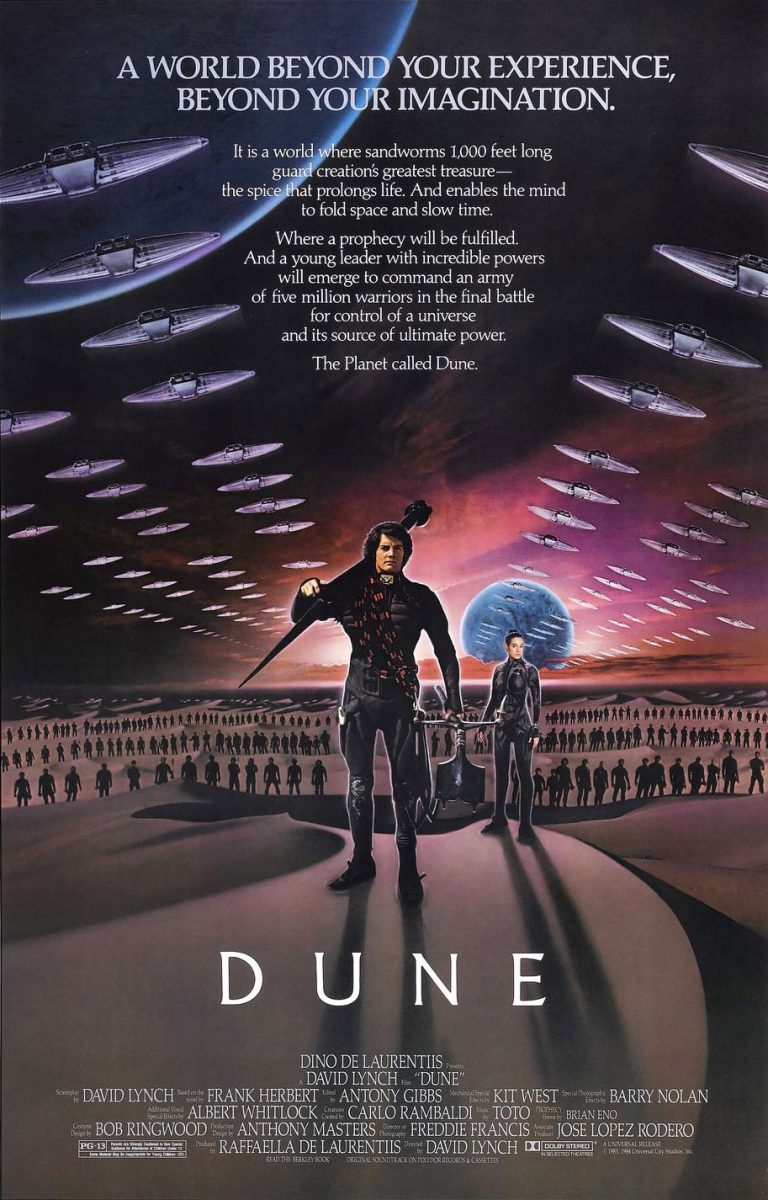With the release of the new entry in the Dune films, many may still be itching for more Dune content. Look no further than the 1984 film of the same name. This earlier adaptation of the film, though similar, is different enough to warrant a viewing of its own. One may even learn to appreciate the new films more after watching the first attempt to adapt the original Dune novel.
The first thing that must be noted is the visuals. Some may call it dated, but the same level of charm is found that is present in the original “Willy Wonka” (1971) and “Star Wars” (1977) films. For its time, the film offers a wonderful abundance of 80s visuals and set designs with heavy shadowing that makes each shot feel like an oil painting with life. The atmosphere designed for this film is a combination that can only be described as Art Deco meets Flash Gordon. There is an older sense of elegance in the rich walls of House Atreides that feels ancient. This goes together with the camera work. Each angle was carefully thought out to make shots of miniatures and puppeteering more convincing. Many of these shots affected pop culture with films like “Alien” (1979) having shots and scenes that pay homage. There are even shots that clearly inspired scenes in the modern “Dune” (2021). Such as the character Vladimir Harkonnen’s eerie floating and vantablack sludge bath or Paul Artreidis researching the planet Arrakis, dubbed Dune, and its inhabitants.
On the other hand, some of the graphics are very dated and it is painfully obvious. Such as the shields. They are depicted as polygons encapsulating their users. The actors in question do a decent enough job of acting as if there is a barrier there. That is if you can keep track of which large holographic rectangle is which character. All with the lovely sound effects of the Atari 2600 sound library. Action shots such as the Harkonan’s siege on The Wall, have fighting choreography that is like staged wrestling. One might expect “The Hulkster” to emerge from one of these sci-fi suits. This is all cut together with somber shots of warriors fallen. The poor fight choreography takes away from scenes that are meant to pull at your heartstrings. One cannot appreciate the character Gurney Halleck charging into battle when his warriors have as much grace as a child with a neat stick.
When it comes to the characters, their depictions can vary and garner mixed opinions if you have seen the newest films. Take the character of Vladimir Harkonnen for example. Both versions of the character show the gluttonous greed that such a vile creature is described in the novel with their own sick iteration of what this slug-like man would appear on the screen. Even hero characters such as Gurney Halleck, played by the ever-fabulous Sir. Patrick Stewart brings a new side to the character that makes one appreciate Josh Brolin’s take on the character. Both have a mesmerizing voice that portrays the authoritative but caring nature one would expect from an honorable warrior. However, this passion is not present in every character. Common tropes from the 80s are as present as a car horn in one’s ear. Any character that is deemed a villain or dubious is dressed either like a shrouded figure resembling Emperor Palpatine or a wild-hair-styled rocker ready to shred some cords. And when it comes to the infamous sandworms, you will need to see for yourself. It is a sight to behold. Overall, Dune (1984) is fun and is clearly inspired by its source material.


STEVE COLEMAN • Sep 28, 2024 at 11:06 pm
Dune is a book that will never be easy to transition to the screen. The problem with the 1984 version was condensing it into a 2 hour film, not possible.
The 2023 and 2024 films are closer to the book, especially in their portraital of the Fremen, making them more in line with how they are described in the book.
In the 1970s when I read the books there was almost a cult feeling around them. Like the cult that grew up around LOTR no version would ever please everyone (In fact in the 1970s and early 1980s there were some LOTR fans who if they found out you had not read any of the books they considered your life to be worthless)
David Lynch with the 1984 version was hampered by interference by the studio suits and virtually disowned it. That is why with the directors cut in the 1990s he did not put his name to it.
No one could ever improve on the gorgeous Francesca Annis as Lady Jessica and Sean Young as Chani, straight off her role as Rachel in Blade Runner. What Hollywood did to her is disgraceful